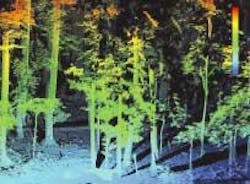NIST advocates development of next-generation LADAR
Recent advances in microchip lasers, optics, microelectromechanical systems (MEMS), and computers have increased the speed of data acquisition, range accuracy, and reliability of laser-detection-and-ranging (LADAR) scanning devices, while also reducing their size and cost. The technique is now used to generate topographic images, to survey the depths of large bodies of water, and as 3-D documentation of construction when building plans are not available (see figure). Manufacturers also are beginning to use LADAR to recreate critical machine components from single examples.
The National Institute of Standards and Technology (NIST; Gaithersburg, MD) is testing LADAR as a tool for remote management of construction sites and for navigation of unoccupied military vehicles. A NIST report issued in May predicts "tremendous" applications for the technology and argues for a vigorous effort to create a compact, high-resolution, fast-frame-rate, next-generation LADAR.1 The results, according to study director William Stone, "could be comparable to the advances achieved when computers were first matched with machinery."
Differences between the two NIST applications highlight the frequent tradeoff between speed and accuracy encountered in LADAR development, according to the report. Systems designed for the construction sites provided relatively high resolution but were much too slow for real-time operation. Systems designed for vehicle guidance achieved the rapid frame rates desired for real-time operation by significantly narrowing the field of view. Both systems, based on currently available technology, are much larger, heavier and more expensive than desired.
"Commercial LADAR systems presently cost anywhere from $25,000 to in excess of $400,000, with $100,000 being the average. Sizes vary but almost none have volumes less than 15,000 cc with masses in excess of 15 kg," according to the NIST report. Although these systems can be hand-carried and set on a tripod, ideal attributes for such systems include a broad field of view and real-time frame rates in a coffee-cup-sized device with a cost on the order of $1000.
The 198-page NIST report assesses available LADAR technology specifically for construction and vehicle-guidance applications. The report also describes designs for vehicle-guidance sensors submitted by Advanced Scientific Concepts (Santa Barbara, CA), Coherent Technology (Lafayette, CO), Lockheed Martin Missiles and Fire Control (Dallas, TX), and Raytheon Missile Systems (Tucson, AZ) in Phase I of a NIST development project that is currently seeking funds to continue into Phase II for design validation and prototype development.
"In the near term, NIST does not expect to see the announcement of any new LADAR products that can meet the BAA (Broad Area Announcement) LADAR requirements specified for driving unmanned ground vehicles," Stone wrote. "Therefore the need is still there."
NIST is also developing test objects for LADAR performance standards to build industry confidence in laser-scanning readings and comparison of systems. Specific LADAR research currently under way at NIST includes work on rapid, long-range automated identification systems for remote scanning and inventory of construction materials; automated LADAR-based docking systems for building construction cranes; and basic scientific and engineering research intended to enable development of miniature, high-resolution, low-cost, next-generation LADAR systems.
REFERENCE
- W. C. Stone et al., Performance Analysis of Next-Generation LADAR for Manufacturing, Construction and Mobility, NISTIR 7117: www.bfrl.nist.gov/bfrlnews/NISTIR_7117_Final_Complete.pdf.

